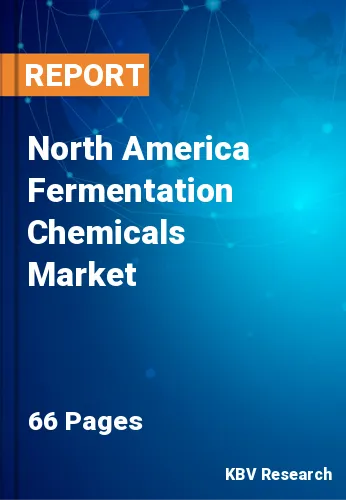The North America Fermentation Chemicals Market would witness market growth of 4.8% CAGR during the forecast period (2019-2025). Ethanol fermentation, also known as alcohol fermentation, is a biological procedure to convert various sugar forms such as sucrose, fructose and glucose into cellular energy resulting in the production of ethanol and carbon dioxide as by products. Mostly, berries, sugar cane, grapes, corn, wheat, rice, honey, potatoes, hops, barley and other plant materials are used for fermentation. Fermentation has its wide variety of commercial applications mostly in the food processing industry. A large variety of bacteria are utilized for the production of pickles, olives and sauerkraut from the raw olives, cucumbers, and cabbage, respectively. Alcoholic fermentation is the foundation for the manufacturing of alcoholic beverages like beer and wine. In few cases, many antibiotics and other drugs are prepared by using fermentation process. For instance, an important drug cortisone is also attained by the fermentation of diosgenin, a plant steroid.
U.S. Environmental Protection Agency (EPA) is continuously working towards limiting the usage and production of chemicals with high risk. The EPA has listed down high risk chemicals in its Toxic Substances Control Act (TSCA) and is rigorously scrutinizing them for risk they pose to humans and environment.
For instance, the U.S. Environmental Protection Agency announced to start the process for exercising limits on two man-made chemicals which are related to serious health hazards such as cancer and other illnesses, and are widely found in soil and potable water. Such chemicals are present in our surroundings for decades and were found useful as they are good at resisting water and oil. These chemicals are found in a number of products, such as food wrappers, non-stick cookware, fire-fighting foam and fabrics.
In addition, EPA has recurrently specified that exposure to isocyanate has been recognized as the chief attributable reason of work-related asthma with prevalence ranging from 1% to 20% among the workforce.
As part of the plan, EPA declares that it has started the process of listing PFOS and PFOA - two kinds of PFAS - recognized as hazardous substances under the Superfund law. It would help communities to deal with present contamination and to recover costs from related parties. The agency announced its plan to step up its work for research into the chemicals' human health of chemicals and ecological properties.
EPA is continuously trying to address the fear and concern with certain chemicals used or produced by the chemical industry in the region.
The report highlights the adoption of Fermentation Chemicals in North America. Based on Application, the market is segmented into Industrial, Plastics & Fibers, Food and Beverages, Pharmaceutical and Nutritional and Other Applications. Based on Product, the market is segmented into Alcohols, Organic Acid, Enzymes and Other Products. The report also covers geographical segmentation of Fermentation Chemicals market. The countries included in the report are USA, Canada, Mexico and Rest of North America.
The major market players expanding their reach in the North America Fermentation Chemicals market are Novozymes A/S, Koch Industries, Inc. (Invista BV), The Dow Chemical Company, BASF SE, Archer Daniels Midland Company, Cargill Corporation, Chr. Hansen Holding A/S, Koninklijke DSM N.V, Ajinomoto Co. Inc. and Evonik Industries AG (RAG-Stiftung).
Market Segmentation:
By Application
By Product
By Country
Companies Profiled
Our team of dedicated experts can provide you with attractive expansion opportunities for your business.

